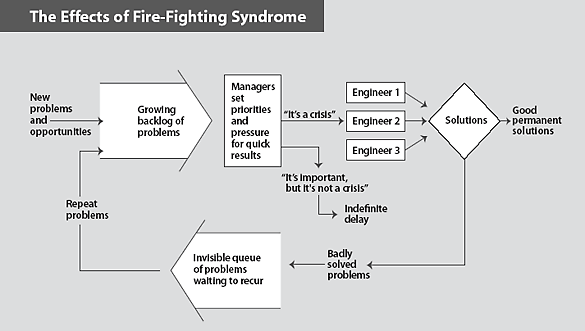In today’s rapidly changing marketplace, Small and Medium-Sized Businesses (SMBs) face unprecedented shifts: evolving customer expectations, new competitors emerging seemingly overnight, and dynamic workforce changes. Too often, the response is a reactive, urgent scramble; a culture of “firefighting” that becomes a significant drain on energy, resources, and morale. To not just survive but thrive, SMB leaders need to consciously break this cycle.
Speed Matters. But Only with a Clear Plan
Organizations rightly recognize the need for speed, pace, and agility. But simply asking teams to “work faster” or “be more agile” without a well-thought-out change agenda often backfires, leading to confusion, misaligned efforts, and ultimately, more fires to fight. This is especially true for technology initiatives, where a lack of upfront clarity can quickly derail projects.
Incumbent businesses, including growing SMBs, face unique challenges: entrenched cultures, process rigidity, and management overhead that startups don’t carry. The drive for speed, without a clear change agenda and strong decision-making focus, can lead to a ballooning pipeline of work that outstrips capacity.
The Growing Backlog: Fuel for the Firefighting Syndrome
When the work pipeline swells and pressure for pace intensifies without clear prioritization, several predictable (and detrimental) outcomes occur:
- Tactical “patching” of problems rather than strategic solutions.
- A “hidden backlog” of unaddressed issues that eventually surface as new crises.
- Increased workplace stress and employee burnout.
- Departure of top talent seeking more stable, focused environments.
- Constant escalations and a “finger-pointing” culture.
- Ultimately, failures in delivery.
As Roger Bohn described years ago in the Harvard Business Review, this “Firefighting Syndrome” is self-perpetuating: as urgent crises consume all attention, important but less immediately urgent work gets parked, leading to more crises down the line. Firefighting breeds more firefighting.

The Solution: Stop Firefighting with Focus, Effectiveness, and Clarity of Purpose
Breaking this destructive cycle and successfully pursuing speed and agility requires a foundation built on three cornerstones. As a fractional CIO, I help SMBs implement these principles, particularly within their IT strategy and operations:
1. FOCUS (Inspired by Jony Ive & Apple’s Discipline):
“Focus means saying no to something that with every bone in your body you think is a phenomenal idea… because you’re focusing on something else.” – Jony Ive
Apple’s success wasn’t built on a “features arms race,” but on a relentless focus on core features that matter most to customers, executed exceptionally well. Many organizations suffer from “everything and” decision-making, where a lack of clear choices leads to ever-expanding scope.
For SMBs & IT: This means being supremely clear about what you want your technology to achieve. IT investments must be ruthlessly prioritized, focusing on initiatives that deliver the most strategic value. Say “no” to phenomenal but non-aligned “shiny objects.” A fractional CIO helps you make these hard choices, ensuring your IT efforts are tightly focused on business-critical outcomes.
2. EFFECTIVENESS (Leveraging Covey’s Wisdom):
Stephen Covey’s Urgent/Important matrix (often called the Eisenhower Matrix) is a powerful tool. The tendency in firefighting mode is to live exclusively in the “Important and Urgent” quadrant.
For SMBs & IT: While crises must be addressed, organizational resources must be strategically allocated. A portion must be dedicated to the “Important but Not Urgent” quadrant. This is where strategic IT planning, infrastructure modernization, cybersecurity preparedness, process optimization, and developing your team’s tech skills reside. By focusing resources here, you proactively build the “ladders” (as discussed in “Snakes and Ladders“) that prevent future fires.
3. CLARITY OF PURPOSE (The Foundation of Strategic Initiatives):
If you don’t know your objectives, desired outcomes, and how you’ll measure success for an initiative, how will you know if you ever achieve it? In today’s competitive landscape, basic business casing, benefits tracking, and clear gating for initiatives are essential.
For SMBs & IT: Before any new technology project or IT initiative earns investment, it needs “clarity of purpose.” As a fractional CIO, I guide clients through asking:
- What specific business problem are we solving or opportunity are we pursuing with this technology?
- What capabilities do we need to leverage or build?
- Who are all the stakeholders (internal and external)?
- What are the specific, measurable benefits (hard and soft)?
- What are the dependencies, constraints, or risks (market, regulatory, technical)?
This upfront work, done with pace but not at the expense of quality, prevents feeding the very fires your delivery teams are trying to extinguish.
What’s Next
These three cornerstones, Focus, Effectiveness, and Clarity of Purpose, are interconnected and mutually reinforcing. Relentless focus controls the immediate crisis, freeing resources to work effectively on important, non-urgent strategic work. This strategic work, driven by clarity of purpose, ensures future initiatives are well-conceived, preventing them from becoming future crises.
If your SMB is spending all its time firefighting, you are actively working against your goals of speed and agility, risking burnout and eventual system-wide failure. As a leader, you cannot accept this cycle.
Is your SMB caught in a firefighting loop, struggling to make strategic headway with your business and technology initiatives? If you’re ready to break the cycle and implement a more focused, effective, and purposeful approach, let’s connect with Succeed Sooner Consulting.


Leave a Reply